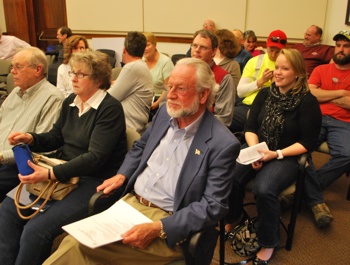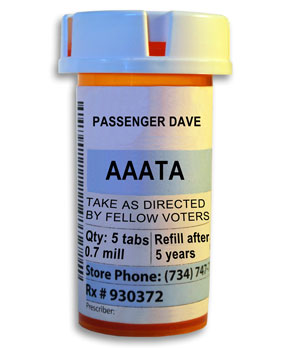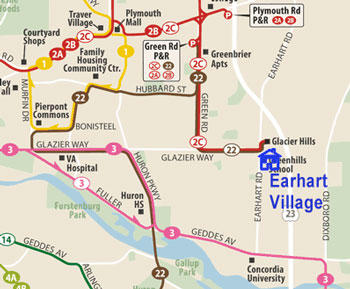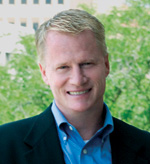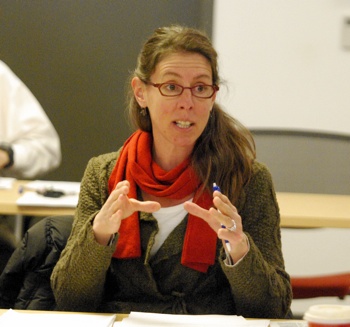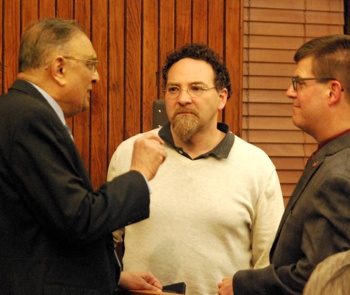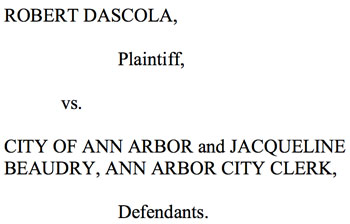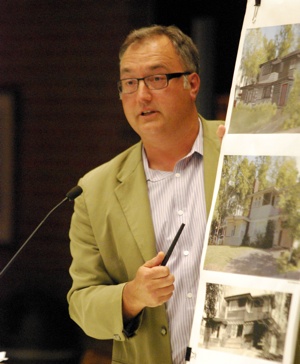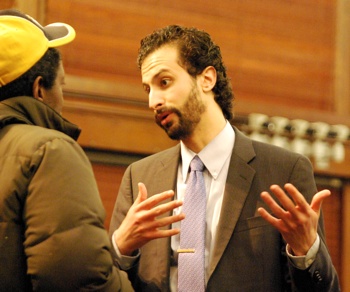May 5, 2014: City Council Live Updates
Editor’s note: This “Live Updates” coverage of the Ann Arbor city council’s May 5, 2014 meeting includes all the material from an earlier preview article published last week. The intent is to facilitate easier navigation from the live updates section to background material already in this file.
The Ann Arbor city council’s voting agenda for its May 5, 2014 meeting is relatively light, but features some significant public hearings and a potentially controversial contract related to footing drain disconnections.

The sign on the door to the Ann Arbor city council chamber, installed in the summer of 2013, includes Braille.
One public hearing will be held on the FY 2015 budget. The 2015 fiscal year starts on July 1, 2014. City administrator Steve Powers presented his proposed budget to the council at its previous meeting, on April 21. The council will take up possible amendments and vote on the adoption of the budget at its following meeting, on May 19.
Separate budget-related public hearings on May 5 will be held on fee increases in the community services area and the public services area. Notable is the proposed increase in the fees for stalls at the farmers market. The annual fee for one stall will increase from $300 to $450.
A significant voting item on the agenda is a roughly $750,000 contract with CDM Smith Inc. for continued work in connection with the city’s footing drain disconnection (FDD) program. In 2012, the city’s program to disconnect footing drains from the sanitary sewer system was suspended by the council in some areas of the city. It has continued in other geographic areas and as part of the city’s developer offset mitigation program, which requires owners of new developments to complete a certain number of FDDs. The purpose is to offset the additional flow in the sanitary system caused by new construction.
The CDM contract could draw scrutiny, because the city is currently undertaking a sanitary sewer wet weather evaluation (SSWWE) study. It’s supposed to yield a recommendation about whether to continue with the FDD program, and if so, in what form. In addition, the city’s ordinance, which requires property owners to undertake FDDs, was challenged in a lawsuit filed earlier this year. That case is pending as the city has removed the case from state to federal court and the plaintiffs are seeking to remand it back to state court. A hearing is scheduled for May 28 on the question of remand.
Also on the agenda are two contracts for general construction inspection work, each for $100,000, with Stantec Inc. and Perimeter Inc.
Three parks will be getting upgrades to play equipment if the council approves a contract with Game Time c/o Sinclair Recreation for $132,000. Arbor Oaks Park and Scheffler Park will have their play structures replaced, and North Main Park will be getting a tire swing and chess table.
Mowing and snow clearance in city parks in the future be handled with two mower/snow-broom combination units, if the council approves the purchase from Spartan Distributors for $101,000.
Three land-use items that were recommended for action by the city planning commission appear on the council’s May 5 agenda.
First, the council will consider giving initial approval to a change in the city’s zoning ordinance related to drive-thrus. In addition to providing a definition, the ordinance revision would require drive-thrus to obtain special exception use permits, which would be allowed only in the O (office), C2B (business service) and C3 (fringe commercial) zoning districts. Drive-thrus would not be allowed in the C1, D1, D2, and other commercial districts. Currently, drive-thrus are allowed in C3 districts without a special exception use. They are allowed as special exception uses in the C2B district.
Second, the council will consider giving initial approval to a rezoning request and area plan for 515 Oxford, to convert a house for use as an annex to the Delta Gamma sorority. The main sorority house is located nearby at 626 Oxford. The request, supported by the city’s planning staff, is to rezone the parcel from R4A (multi-family dwelling) to R2B (two-family dwelling and student housing). The building is notable because it was originally designed in 1940 by architect George Brigham, who used it as his home and architectural studio.
And third, the council will consider final approval for the rezoning of land that’s been donated to the city by developer Bill Martin, founder of First Martin Corp. The 2.2-acre parcel at 3301 Traverwood Drive is being added to the adjacent Stapp Nature Area, near the Leslie Park golf course.
Sidewalks are again on the agenda in the form of a public hearing on the proposed Newport Road special assessment, which is supposed to help fund a stretch of sidewalk north of Wines Elementary School. And the council will consider the acceptance of an easement for a sidewalk at 2300 Traverwood Drive.
The council will also consider a routine item this time of year – transferring delinquent water utility, board-up, clean-up, vacant property inspection, housing inspection fees, and fire inspection invoices to the city tax roll for July 2014. The council will also be asked to approve the denial of claims against the city by the board of insurance administration.
Management of the deer population will receive some attention in the form a resolution on the May 5 agenda that directs the city administrator to partner with other organizations to develop strategies for deer management. The administrator will be asked to report back to the city council by July 31, 2014 on the status of the partnership, including budget and timelines. The resolution, put forward by Jane Lumm (Ward 2), states that the desired outcome is a community-endorsed deer management plan.
Appointments to the city’s environmental commission (EC) are on the May 5 agenda, having been postponed at the council’s April 21 meeting. All three that appeared on the April 21 agenda were reappointments for currently serving members of the EC: Kirk Westphal, David Stead, and Susan Hutton. However, the intention at the May 5 meeting is to substitute the original resolution with one that does not include Stead. In addition, a separate item has been added, after initial publication of the agenda, to nominate and appoint Katherine Hollins to the EC.
Street closings on the agenda include: East Washington for the Ann Arbor Book Festival on June 21; East Liberty for Sonic Lunch on Aug. 21; and several neighborhood streets for the 2014 Glacier Area Homeowners Association Annual Memorial Day Parade on May 26.
An item added to the agenda on May 2 is a resolution that would remove any reference to felony convictions on city job applications.
This article includes a more detailed preview of many of these agenda items. More details on other agenda items are available on the city’s online Legistar system. The meeting proceedings can be followed Monday evening live on Channel 16, streamed online by Community Television Network starting at 7 p.m.
The Chronicle will be filing live updates from city council chambers during the meeting, published in this article below the preview material. Click here to skip the preview section and go directly to the live updates. The meeting is scheduled to start at 7 p.m. [Full Story]




